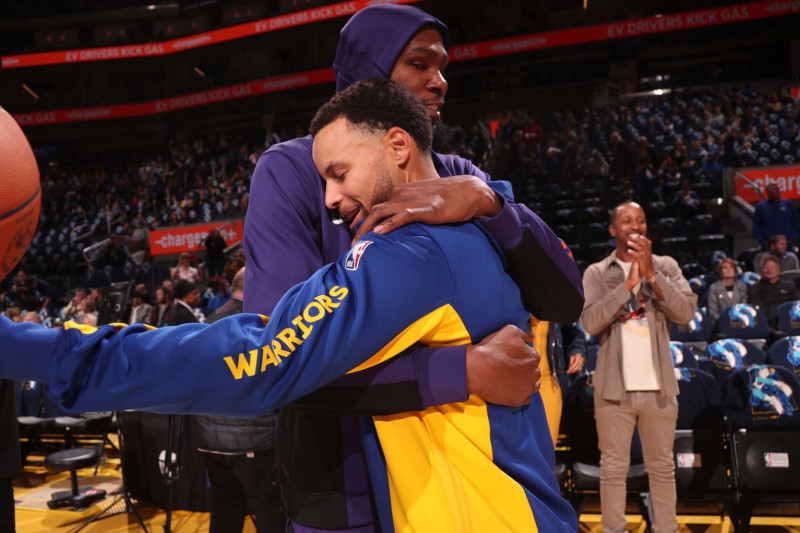
When Kevin Durant and the Golden State Warriors joined forces in the summer of 2016, they became instant villains because, for many reasons, they didn’t need each other.
Golden State had a unanimous MVP in Stephen Curry, a young and balanced supporting cast, a championship and a record-setting 73-win season in its recent past. KD had his own MVP award, unquestioned top-five-in-the-league status and a highly successful Oklahoma City Thunder squad that desperately wanted to keep him.
The two superpowers united anyway, triggering a great deal of analysis that involved words like “overkill” and “unfair.” Outside of the Bay Area, it was impossible to root for them. All parties involved were front-runners. Bandwagon jumpers. And those were the polite criticisms.
Were KD to return to the crumbling Warriors via offseason trade, attitudes would be totally different this time. Forget Durant being labeled a coattail-rider.
He’d become a savior.
With the once-dynastic Dubs fading and Durant’s Phoenix Suns facing one of the bleaker long-term outlooks in the league, everything is different.
The Warriors’ uneven season and Play-In dismissal proved they’d grown too old and too slow—not exactly a shock for a club led by players in their mid- and late-30s. They appeared to need more youth and athleticism.
Durant would provide little of either, but what if Golden State steered into the skid instead? What if the better play is actually doubling all the way down, destroying the second timeline and delivering Steph, Klay Thompson and Draymond Green one of the few veteran stars capable of maybe making a “one last ride” gambit pay off?
The Large and Varied Obstacles to a Reunion
There are a million reasons for the Warriors and Durant not to do this.
Golden State would have to surrender virtually all of its young pieces and draft equity to even get the Suns’ attention. Two or three of Jonathan Kuminga, Brandin Podziemski, Moses Moody and Trayce Jackson-Davis would have to be in any outgoing package along with the three future first-rounders the Warriors are allowed to trade. Andrew Wiggins, who’s hard to label a positive-value asset at this point, would be the salary ballast necessary to match Durant’s $51.2 million 2024-25 pay rate.
That’s a full vaporization of future flexibility, not unlike the one the Suns engineered to land KD from the Brooklyn Nets.
Despite Phoenix facing a historically ugly long-term outlook that could be brightened by moving Durant, it may not want to pivot away from its bold plan after just one full season. The Suns’ deals under new governor Mat Ishbia seem reckless and hasty in hindsight. Shifting so quickly would add “frivolous” to the mix.
And KD would be justified in wanting nothing to do with another tour of duty alongside Green in Golden State, particularly after souring on the experience relatively quickly the first time.
Durant may view a return to Golden State not as a shot to deliver salvation but as an unthinkable tail-between-legs admission of failure. He said he wanted to experience basketball elsewhere when he left, tried two different hand-picked spots and didn’t love either of them. Forever online and conspicuously concerned with what anonymous keyboard warriors think, Durant might already see the criticism of a second Dubs tenure coming and want no part of it.
Why It Should Happen Anyway
The Warriors’ side of things is much less complicated.
Yes, bringing Durant back would be a shortsighted, all-in move. But it would be in service of Curry, giving him the semi-realistic chance to contend that the organization rightly believes it owes him. And if chasing one more ring with Durant seems improbable, well…it is. But it’s not any more far-fetched than trying to accumulate more athleticism and youth than the rising Oklahoma City Thunder, matching the Minnesota Timberwolves’ size or running it back with the same core in hopes of mirroring the Denver Nuggets’ elite continuity.
Framed another way, the Warriors are now chasing several teams in the West, and they can’t catch up by conventional means. Better to circle back, return to something familiar that worked (until it didn’t) and see if what was once labeled unfair could, in a diminished state eight years later, be something close to “good enough.”
Neither Durant nor the Warriors are what they used to be, but that’s what makes the narrative element in all this so compelling. Isn’t there something noble about one last fight with worn-down versions of players who once dominated? A last stand, together, against long odds, with the last rays of a once-brilliant sun dipping below the horizon?
It’s storybook stuff.
Durant may not be quite so sentimental about the whole thing, but he could justify coming back on practical grounds.
Phoenix has no outs. It’ll pay over $150 million to Durant, Devin Booker and Bradley Beal next season. Its second-apron status means it can’t aggregate salaries in any deal, take back more money than it sends out or utilize any roster-building tools like the mid-level exception. It has no picks to trade, no young talent likely to improve and seems almost certain to fire head coach Frank Vogel.
Staying with the Suns seems foolish. Joining another team that’s much closer to contention would subject Durant to more of the same bandwagon-jumping jabs he endured when he signed on with the Warriors the first time—not to mention more criticism about team-hopping in a futile, itinerant search for basketball fulfillment.
Maybe Durant doesn’t feel like he needs redemption. Maybe the Warriors don’t believe they require a savior. Maybe it’d be best to leave the past behind.
Or maybe, for both KD and the Warriors, going back is the only way forward.